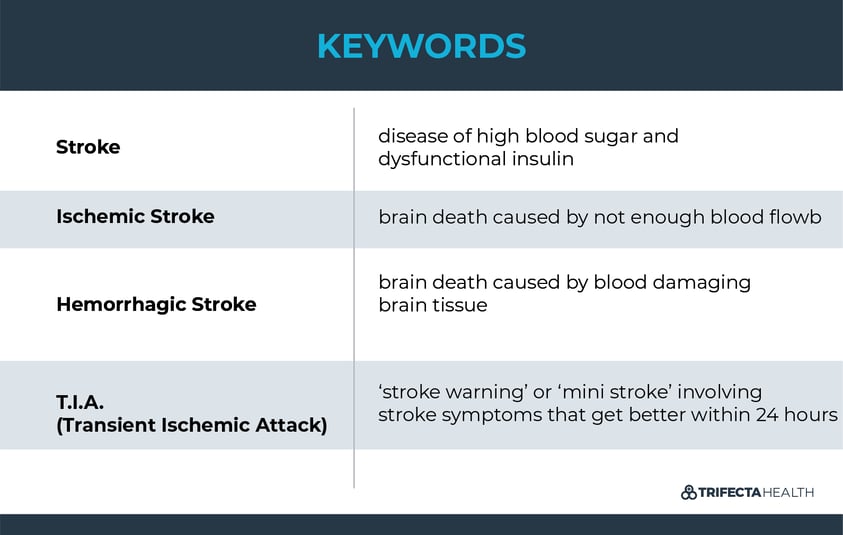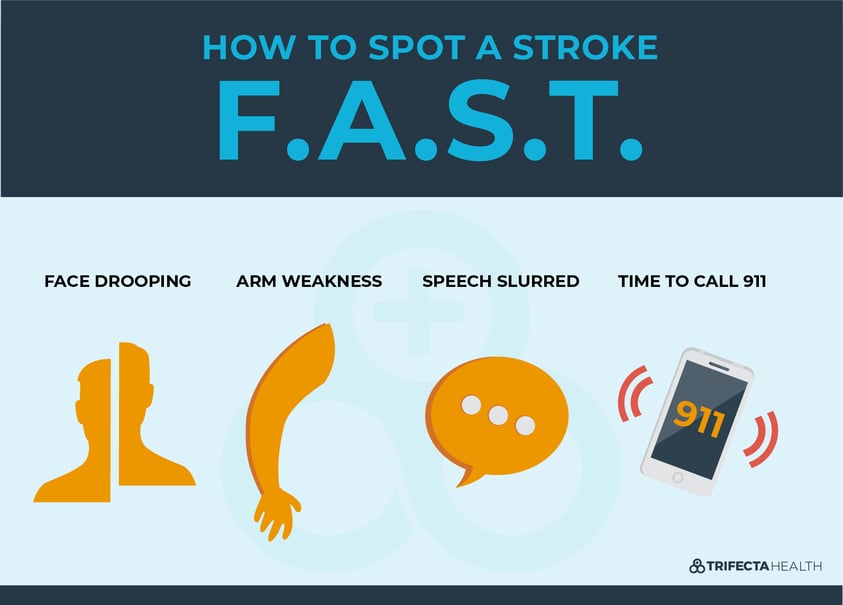From devastating loss of movement and mental function to death, about 800,000 people suffer from stroke in this country each year. It is the 5th leading cause of death in the United States (1).
While the development of a stroke can be complicated, up to 80% of all strokes are preventable by factors each of us can change in our everyday lives (2).
This article includes all you need to know about strokes: what they are, how to recognize them in yourself and your loved ones and how to prevent them.
What is a Stroke?
A stroke is brain tissue death. You may also hear it referred to as a CVA (cerebrovascular accident).
The two main types of stroke emerge in extreme opposing conditions.
Strokes occur when there is not enough blood flow to parts of the brain (ischemic stroke) or there is bleeding within the brain (hemorrhagic stroke).
Ischemic Stroke
About 80% of all strokes are ischemic (3). An ischemic stroke often occurs when there is a blood clot in one of the vessels. This clot blocks blood from reaching downstream brain tissue.
This tissue dies if it doesn’t get the necessary oxygen and nutrients that blood carries to all parts of our body.
Hemorrhagic Stroke
A hemorrhagic stroke occurs when blood leaks out of one of the vessels into brain tissue. This can occur if a blood vessel spontaneously bursts, like in an aneurysm. It can also happen by force, like if there is direct trauma to the brain. Blood directly pouring onto brain tissue damages it.
What are Stroke Symptoms?
Sometimes symptoms of a stroke start with a sudden severe headache. However most of the time people may not experience any pain. Instead most people present with what are called ‘focal findings’.
Signs of a stroke include:
- Focal Weakness
- Slurred Speech
- Imbalance
- Confusion
- Dizziness
- Numbness
- Vision Changes
- Coma
- Death
Seeking immediate medical attention with any of these symptoms is key in stroke treatment.

What is a TIA?
A transient ischemic attack (TIA) can look just like a stroke, but the symptoms get better within 24 hours. It happens when there is decreased blood flow to the brain. The brain cells are injured but don’t die completely.
TIA’s can be thought of as a stroke warning, and are sometimes referred to as a ‘mini stroke’.
People with TIAs have a much higher likelihood to develop strokes in the future. Therefore doctors often prescribe medication and recommend aggressive lifestyle changes to help decrease the risk of future strokes as much as possible in people with TIAs.
What Causes a Stroke?
There are many risk factors for a stroke. We’ll break them down into ones that are preventable and ones that are not preventable. Individuals with one stroke have a higher likelihood of more strokes in the future (1).
Don’t forget, 80% of all strokes are preventable!
Preventable Stroke Risk Factors
- Obesity
- Hypertension
- Smoking
- Diabetes
- High Cholesterol
- Heart Disease
- Physical Inactivity
- Illicit Drug Use
- Excessive Alcohol Use
Non-Preventable Stroke Risk Factors
- Age (older)
- Gender (male)
- Race (African American)
- Comorbid Genetic Disease (ie: Sickle Cell Anemia)
- Family History
How to Treat Stroke?
The mantra “time is brain” is often used because people have improved chances for a better recovery if they get to a hospital quickly.
How to Recognize a Stroke
The National Stroke Association uses the acronym FAST to encourage everyone to quickly identify a stroke (4).
Face: Ask the person to smile. Does the face droop?
Arms: Ask the person to raise their arms. Does one arm drift downward?
Speech: Ask the person to repeat a simple phrase. Is their speech slurred or strange?
Time: If you observe any of these signs, call 9-1-1 immediately.
At the hospital, the doctors will determine what type of stroke is occurring as this will determine the best treatment.

Treating Hemorrhagic Stroke
If the stroke is hemorrhagic, the goal is to limit any additional bleeding. Doctors may give medicine and sometimes do special surgeries or other procedures to try to prevent additional brain tissue damage.
Treating Ischemic Stroke
In ischemic stroke, the goal is to encourage blood to reach more brain tissue. There is often a blood clot that is blocking the blood vessel. Sometimes doctors use medicine or do surgical (endoscopic) procedures to open up the vessel and allow blood to flow more freely to supply the brain tissue.
Clot Busting Drugs
Tissue Plasminogen Activator (tPA) is a type of medication often referred to as ‘clot busting drug’. The goal of this medicine is to break down the barrier preventing blood flow through the vessel in ischemic strokes.
TPA may help many people to recover from a stroke. However, it can also be very dangerous by causing bleeding in the brain. It is therefore only used in very low risk situations.
Stroke Survival
Some people with minor strokes may completely recover and regain their normal functioning. However over 2/3rd of affected people suffer from some type of long term disability from brain damage while many others may not survive (5).
Various long-term treatments can help re-train the body for improved brain control after a stroke.
Speech Therapy
Many people suffer from either difficulty speaking, understanding or swallowing after a stroke. Speech therapy can help improve these functions.
Occupational Therapy
Occupational therapy can utilize a variety of techniques and supporting tools to help people with disabilities start activities of daily living again. This includes simple activities done on a daily basis like getting dressed, brushing teeth, eating, ect.
Physical Therapy
Physical therapy can help to provide targeted exercises that will help strengthen weak muscles and help the brain to remember muscle and coordination skills it may have lost.
Bottom Line: All of these therapies can be effective treatments in helping to regain function after a stroke. While they can't help everyone in the same way, they usually provide some benefit and always warrant a try.
How to Avoid a Stroke?
People who have already had a stroke have a 20% chance of suffering from a second one (6).
Whether you have already had a stroke or are the picture of health, I think everyone would agree that this is something we really want to prevent.
Avoiding strokes involves changing our lifestyle in ways that decreases the risk of many other diseases (7).
Blood Pressure Control
One of the biggest risk factors for stroke is consistently elevated blood pressure. Just because you don’t feel symptoms of high blood pressure doesn’t mean your body isn’t being damaged by it.
Elevated blood pressure is often called the ‘silent killer’ because you can’t feel symptoms until it’s too late - when you’ve had a devastating health event such as a stroke.
Regularly check your blood pressure to ensure it’s consistently controlled. Eating a calorie controlled low sodium diet, regular exercise, and taking your blood pressure medications will all help to keep it in check.
Exercise
Physical activity not only helps with weight loss but it can independently improve heart health and subsequently reduce the risk for strokes.
Quit Smoking
Smoking clogs arteries and leads to numerous terrible health problems including stroke, heart attacks, cancer, lung problems and so much more. Just quit smoking.
Lower Your Cholesterol
High levels of ‘bad cholesterol’ (LDL) can contribute to blocking the vessels that lead to stroke. Improving your cholesterol through dietary modifications, exercise and medication (if prescribed by your doctor) is an important step towards preventing stroke.
Take Your Medications As Prescribed
While most people would agree they would prefer to just be healthy without taking pills, medicine can play a very important role in reducing the risk of stroke. In particular medication for blood pressure, diabetes, cholesterol, blood thinners, and aspirin are all very important to consistently take if they are prescribed by your doctor.
Don’t Use Illicit Drug Use
Illicit drugs are bad for all sorts of reasons. One of these reasons is that they can cause strokes - especially stimulant drugs like cocaine and methamphetamine.
Don’t Drink Too Much Alcohol
Drinking too much alcohol starts to affect your heart and often causes an abnormal rhythm called atrial fibrillation that can lead to stroke. If you do drink alcohol keep it within the moderate recommended range. Follow up with your doctor regularly to ensure your heart isn’t being negatively affected by your lifestyle.
Weight Loss
Obesity is an independent risk factor for stroke. Furthermore it increases the risk for developing other diseases such as diabetes, heart disease, hypertension and high cholesterol.
Calorie controlled low sodium diets and weight loss meal plans are cornerstones in weight management and preventing devastating strokes.
Get portion perfect, healthy meals delivered to your door. Our team of nutrition experts will do the shopping, planning, and cooking. All you need to do is heat them up and dig in!
